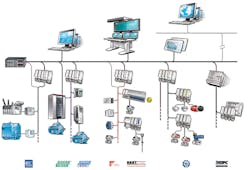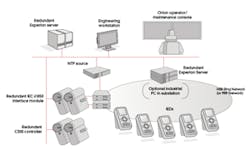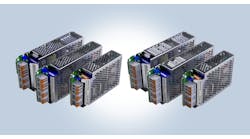The separation between process control and power is one of the oldest organizational barriers on the plant floor. However, digital data is starting to flow more freely between them, and their convergence is allowing users to achieve many and varied gains, improve efficiency and reliability, and reduce costs at the same time.
"We're seeing demand for integration of electrical control and process control across the board among our clients from hydropower to large production plants, mostly due to greater awareness of the IEC 61850 standard," says Brian Harrison, president of Coast Automation Inc., a CSIA-member system integrator in Vancouver, B.C. "I think it began six or seven years ago, when users tried to settle on a common programming language based on the IEC 61131 standard, and then this commonality spread via the fieldbuses and Ethernet-based protocols. Of course, everyone is looking for efficiency and energy savings, and IEC 61850 lets them look at power use at the production level, add meters to their motors and drives, and monitor their consumption and efficiency on a combined SCADA package."
Debbie Colclazier, product marketing manager for DeltaV engineering tools at Emerson Process Management, confirms that power and process control systems are coming together. She recently returned to Emerson from working for eight years at a U.S. oil and gas refinery, and reports its staff could see benefits from combining power and process systems.
"We put in a large compressor with a variable-speed drive at the refinery where I worked," says Colclazier. "The compressor had its own substation, breaker control and PLC. The interface to the PLC from the DCS, combined with hardwired inputs, allowed operators to initiate sequences needed for starting or stopping the compressor. The interface consisted of a sequenced set of communications between the PLC and the DCS to open and close breakers as needed, as well as providing the status of the sequenced events to the operators. In the past, electronic devices used in substations had their own PLC-type controls that could interact with a main PLC to monitor and control those devices. The DCS controls and the electrical substation controls have remained primarily separate until now, with maybe only a few values being integrated via Modbus to the DCS."
Happier together—in Brazil
The benefits of combining and coordinating electrical and process controls and their related systems can be huge, and achieve unprecedented efficiencies and joint performance gains. For instance, at Petrobras' Presidente Getúlio Vargas (Repar) refinery just north of Araucária, Brazil, engineers report that integrated process and power systems from ABB have saved 30% in engineering costs, 14% in installation time and 20% in training costs, according to Leandro Monaco, global product manager for ABB's 800xA system and electrical integration (Figure 1).
Figure 1: Integration of process and power on ABB's System 800xA includes common interfaces that can access substation automation, electrification, instrumentation, safety devices and controls via various fieldbus protocols, IEC 61850's manufacturing message specification (MMS) and generic, object-oriented substation event (GOOSE) messaging.
Credit: ABB
Likewise, Vale S.A.'s huge iron ore mine in Carajás, Brazil, has been working with ABB to develop an integrated, remote asset management and predictive maintenance program for the mine's electrical systems, which would also improve its planned energy efficiency. "The ideal management of a plant isn't just increasing production, but is also relating that production to energy consumption," state Monaco and Jose Catarino, Vale's automation and electrical coordinator, who co-authored a whitepaper on the project. "Production depends on the electrical system always being on, but users don't want to know more than that they can always plug in and run their process, even though one electrical device failure can shut that production down. So power systems don't get much attention, most electrical maintenance has been mainly corrective, and this usually means hours of lost production."
These efficiencies are crucial because the mine represents an almost $19.5-billion total investment, and when it begins production shortly, its 2,600 employees are expected to produce 90 million tonnes of iron ore per year. This will reportedly make it the second-biggest iron ore mine in the world behind Vale's other Brazil-based mine that produces 130 million tonnes per year. However, it will use a truckless system, which will reduce diesel fuel costs by 71% compared to its sister mine, so electricity will be its highest raw material cost. Its electrical system will have 73 km of 230-kV transmission lines, 77 disconnectors and reclosers, and 135 medium-voltage (MV) substations with 1,500 to 2,000 intelligent electronic devices (IEDs). The mine's processing plant will have 30 substations, including one high-voltage and 29 MV, as well as 500 IEDs and 12,000 MV and low-voltage (LV) motors.
"One study showed that 63% of electrical maintenance hours resulted in no needed action, which is a big drain on labor," explain Monaco and Catarino. "And a second study showed that 62% of plants use preventive maintenance or just run to failure, which is not good because electrical equipment is high-value and can cause production to stop. We're proposing one way to do predictive maintenance. Bringing in open/close counts, trip counts, operating current values, spring-charging times and trip circuit supervision data into an asset management function of a unified automation system for process and electrical applications can help avoid these traditional problems. Combining production data and energy consumption also enables greater energy efficiency. We have to measure precisely and in real time how energy is coming into the plant; check how it's being distributed to each production area; do detailed measurements down to the LV and MV motors; and monitor the real-time ratio between plant production rates and energy used."
They add the plant uses a fiberoptic network with all meters and switchgear in one place and logic interlocks between relays. This reduced cable requirements by 110 km and enabled implementation of MV motors that comply with the International Electrotechnical Commission's IEC 61850 standard (see "The basics of IEC 61850"). "Vale has also saved about 4 million man-hours in pulling cables and in installing, commissioning, testing and maintaining devices," added Monaco. "The mine also needed 83% fewer power meters in its substations, but has the same functions, gets the same information from its automation systems, and receives per equipment and plant reports. As a result, it also needs 75% fewer maintenance personnel."
Saved by substation standardization
Despite present and future gains, the path to electrical/process control integration has been long and circuitous, but it began to straighten and shorten with the advent of standards like IEC 61850 for designing electrical substation automation.
"In many regards, integration of process and power control has been happening for a long time," says Paul Vellacott, solutions marketing manager for SCADA systems at Honeywell Process Solutions. "What's changed is relays have gotten smarter, and with standards like IEC 61850, more data and control is reliably available via communications interfaces. The realization now is it's not absolutely necessary to have these as completely separate systems. Load shedding, power control, mode control, synchronization and other functions can be performed from the same type of HMI and controller. It's just the end devices that are different, though I don't think we're at the stage of networks coming completely together. In fact, many aspects of load shedding can be configured in the IED network, rather through a separate PLC. And when something goes wrong, the operator has access to all the information, not just process, so if a high-voltage relay tripped at the same time, they can be analyzed together. And maintenance teams can make decisions remotely about how to fix the situation and even change IED parameters, so there's no need to punch local panels anymore."
Faster projects, powerful pictures
Figure 2: By providing power and electrical management data directly to operators and power control data directly to process controllers, Experion PKS Orion from Honeywell Process Solutions and IEC 61850 substations become one process and power automation solution.
Credit: Honeywell
Harrison reports that Coast worked with renewable energy provider Innergex in 2014 to build controls for a 50-MW, run-of-river hydropower plant in British Columbia, which was greatly simplified and streamlined by combining its electrical and process controls. The project implemented Schneider Electric's Unity software in three M340 PLCs and used its Wonderware System Platform SCADA software and chart-server-based, unified design platform.
"All its controls have familiar interfaces, common function-block programming and tag naming conventions, and unified interfaces to all power devices," explains Harrison. "These all made the project, commissioning and training easier. We had less programming and spaghetti code, and easier troubleshooting. Compared to a similar plant we did previously that didn't combine power and process controls, I think we spent 25-50% fewer hours on commissioning and saved 10% on engineering time, even though more time was spent at the beginning."
Likewise, Honeywell reports its Experion PKS Orion control system also supports IEC 61850 across its automation hierarchy with a SCADA interface connecting Experion's HMI to electrical substations and a control-level Series C interface to connect process controllers directly to IEC 61850 devices. By providing the power and electrical management information directly to the operator and the power control information directly to the process controllers, Experion and IEC 61850 substations become a single process and power automation solution (Figure 2).
Tools for cooperation
To help users take advantage of unified power/process controls, many suppliers are developing software and devices they can use to tailor newly combined systems to their applications, monitor and coordinate their performance and gain the most inefficiencies from them.
Colclazier reports that Emerson is using the IEC 61850 manufacturing message specification (MMS) protocol in its new Ethernet I/O Card (EIOC), which can talk to 256 different devices, handle 32,000 signals and will be released with its DeltaV distributed control system, Version 13.3, in September. "MMS brings monitoring and supervisory control of electrical subsystems to the DCS, as the EIOC can connect directly to the IEDs to read process variables and display them for the operator in DeltaV," explains Colclazier. "In the past, some variables could be delivered via Modbus and serial interfaces to a substation PLC, but users had to decide and program values that needed to be mapped for integration purposes. And since the systems are dealt with totally separately within organizations, this was rarely done.
"With the IEC 61850 MMS protocol, we can read and write data directly to/from IEDs. EIOC can deliver information from the IED without a gateway or PLC, which allows real-time monitoring and supervisory control. Any IED supporting the IEC 61850 protocol can be added to the EIOC network. Imagine being able to bring the information from all the substation devices into one place, the DCS, where you can have alarms monitored by operators and help prevent substation events. This gives users the ability to historize values and events to help troubleshoot substation events. This means less need for laptops in the field, connecting to the devices for data and no need for separate monitoring systems for each vendor's devices, from which it's difficult or impossible to get data into a plantwide historian. The EIOC breaks the chain of the disjointed monitoring of electrical substations by connecting IEDs directly to the DCS."
Bruce Jensen, manager of systems product management at Yokogawa Corp. of America, reports, "Our philosophy for integrating power and electrical systems is to make them subsystems of the process automation system. Yokogawa employs its Unified Gateway Station (UGS), which uses the Yokogawa NIC card for access to the control LAN and an Ethernet physical interface to the electrical/power subsystem. UGS bridges the Ethernet interface of the electrical/power system and the Vnet/IP protocol of its Centum VP DCS system, and provides the structure to create a tag and parameters of the interested data.
"Once a tag is on the control LAN, all stations on the control highway can use the data in the same manner as hardwired, connected process data, including operator graphics, OPC interface to supervisory systems, and in KPI calculations. Yokogawa also provides an integrated operation and monitoring IEC 81650 browser in its UGS builder, which uses MMS to access specific information of interest."
Much of the credit for enabling closer integration of power and process controls goes to the International Electrotechnical Commission (www.iec.ch) and its IEC 61850 standard for Communication Networks and Systems in Substations, including designing electrical substation automation, and facilitating communications and interoperability of intelligent electronic devices (IEDs) in modern power grids.
Issued in 2004, its objectives are to use open protocols that support self-descriptive devices; to make it possible to add new functionality; to base its complete communication profile on existing communication standards; to be founded on data objects that relate to the needs of the power industry; and to enable high interoperability of IEDS from different manufacturers.
The heart of IEC 61805 consists of object-oriented data models that facilitate semantic commonality of electrical infrastructure functions among systems and devices. The standard's present edition also defines an Ethernet-based, high-speed means of communicating generic object-oriented substation events (GOOSE) horizontally among IEDs for interlocks and protection schemes, as well as a TCP/IP-based manufacturing message specification (MMS) for vertical integration into supervisory systems.
While power transmission and distribution systems were its main initial targets, IEC 61850 also affects power-generation and process applications by increasing the visibility of operating and diagnostic data from electrical assets. Electrical integration via IEC 61850 provides seamless control room access to real-time operational data and diagnostics for integrated system users.
IEC 61850 also saves the hardwiring previously needed by the IEDs it helped replace. Ethernet connectivity means I/O and its former hardwiring aren't required for communication among IEDs, which means fewer terminations, lower installation costs and improved organization within substation cubicles. Also, its fiberoptic networks mean communication links can run closer to busbars without risking electromagnetic interference.







